by Jeff Nesler
On a Road Scholar group tour of Puerto Rico in mid-November, several international Girl Scouts and Girl Guides celebrated their milestone reunion. The ten tourists, converging for the 60th Anniversary of their first encounter, included two husbands. This writer was one of another ten members of the tour group, with travelers from the U.S. and Canada. Road Scholar, established in 1975, offers 6,500 educational tours in the U.S. and 150 countries each year. Puerto Rico’s history, terrain and culture were the subjects of this weeklong excursion.
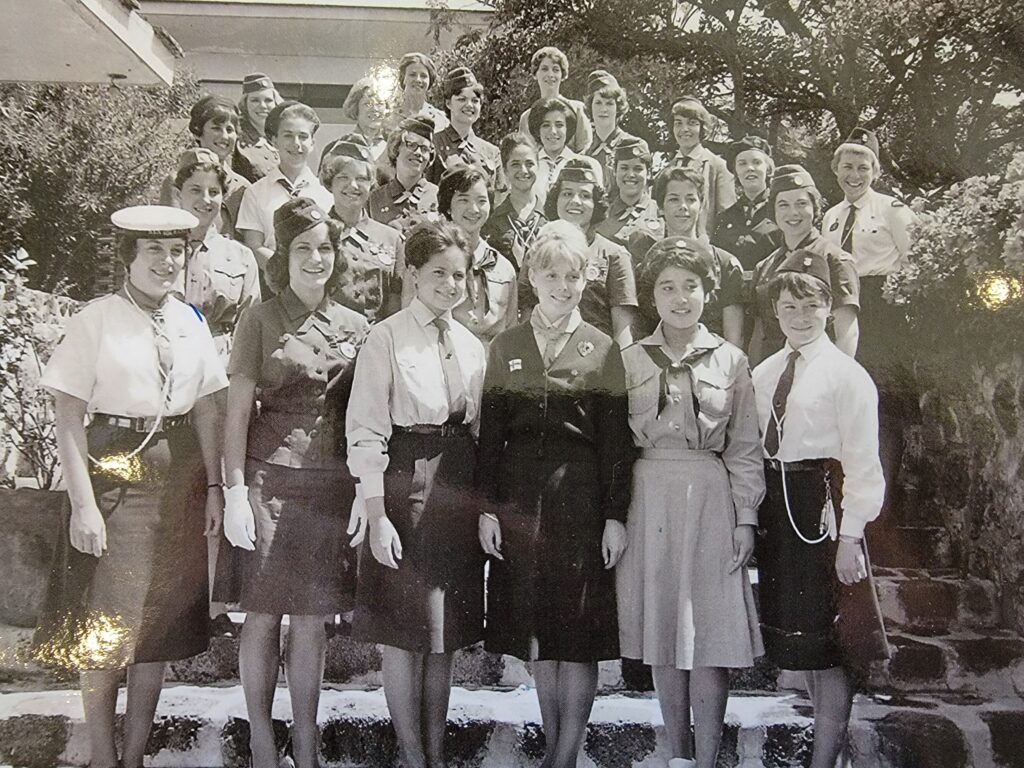
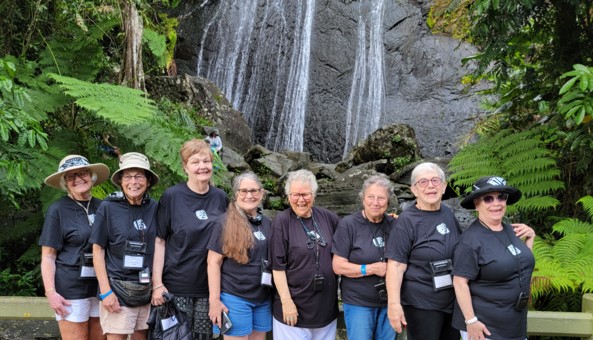
Sixty years ago: They met in Cuernavaca, Mexico, at a Girl Scouts/Girl Guides center, La Cabaña, for a leadership gathering in 1963. Thirty young women and their two leaders met, and since then, they have done their best to remain in touch and meet every two to five years, with one member hosting in their native country.
The group named itself Wata Jarobu, an acronym for “‘We’re All Together Again,’ plus the first two letters of the three dormitories at the La Cabaña center where we met; the Mexican flowers Jacarandas, Rosas (roses), and Bugambilias,” said Lydia Rivera-Abrams, known to all as “Techi Rivera” or simply “Techi.” Wata Jarobu comprised 26 young women from 10 countries: two each from Australia, Brazil, Canada, Finland, Italy, Japan, Mexico, Puerto Rico, Switzerland, and eight from the U.S. “We were chosen 60 years ago to represent our countries because the individual Girl Scout councils and Girls Guides saw in us a quality of leadership that they felt better represented their country,” Rivera said.
“Spending three weeks learning and living together really bonded us for life,” said Rocio Smith, who was born and raised in Mexico before moving to California. “I thought it was such an incredible gift to be part of that original group, learning things that when you’re 17 or 18, you think you know everything. We didn’t. We learned a lot from each other, and then the group remained together in communication.”
A Caribbean jewel: Americans have a hassle-free time visiting the travel destination of Puerto Rico, a U.S. territory that requires no passport, currency exchange, or international phone plan. The tourism sector here is growing, with demand increasing by 12% in the first seven months of 2023, and is on course to beat its 2022 record of $8.9 billion in tourism revenue. If you’re looking for Caribbean beaches, cultural experiences, world-class culinary delights, natural wonders, or thrilling adventures, it’s the perfect island to visit.
Our guide, Andrea Torres, spent all seven days with the 20-member tour group, making meal arrangements and giving advance presentations as we rode on a comfortable tour bus toward each destination. She informed us about the history, geography, nature or culture we were about to witness at each stop and led several excursions. The itinerary curated tours and activities: the historic San Cristobal Fort, mural art in the Miramar district, a tropical fruit farm, a coffee plantation, a mofongo cooking lesson, a Plena and Bomba dance lesson on the beach, a hike through the El Yunque National Forest and more. This article looks at the majority of our group’s excursions, as well as the story of Wata Jarobu.

Castillo San Cristobal, a historic fort: The tour began in old San Juan with guide Christian Santiago at one of Puerto Rico’s most popular tourist sites, Castillo San Cristobal. Our group of Road Scholars learned much about this massive military fort built by the Spanish army in the 17th century to protect the city of San Juan from invaders. An expert in Puerto Rican history, Santiago delved into the island’s military history, the fort’s importance, the strategic location of this island as a trade hub, and how the original name of Boriken gave way to the Spanish name of Puerto Rico, “rich port.”
Now a UNESCO World Heritage Site, the fort also was designed to catch and retain up to 800,000 gallons of water in five cisterns under its central plaza, whose limestone bricks and tiles, to this day, filter the water as it descends.
Getting acquainted with Wata Jarobu: Between anniversary reunions, the women and their families remain in touch throughout the year. Despite differences in nationality, culture, and even political persuasion, they are like a family, with two more generations of sons, daughters and grandchildren also becoming friends. “My family, my kids know the kids of other Girl Scouts and are friends with them,” Smith said.
“Each pair that represented their country was assigned a different Girl Scout council in the U.S. after the Cuernavaca meeting,” Rivera said. “When we split and separated in Mexico, we spread out all over the different United States, but we swore we would try to keep in touch. A few years after that, we couldn’t wait to see each other again, and ever since, there have been different reunions and get togethers, some two years apart, some five years apart. This week, we celebrate the 60 year reunion since 1963.”
This year, friends from Canada, Italy, Mexico, the U.S. mainland and Puerto Rico converged for this Road Scholar tour. Others could not join due to personal concerns, such as health issues. Otherwise, the group (as many as 26, not including husbands, sons, and daughters) might have taken a private excursion (with a minimum size requirement of 20) via Road Scholar.
“Not everyone comes, but the spirit of the meeting in Mexico 60 years ago is what continues and keeps on giving,” Rivera said.
“But you know, it’s so much more fun to have other people to bring into your family,” Smith said. The group Wata Jarobu, who were between 15 and 18 when they met, as septuagenarians today welcomed the other Road Scholars to their international family. We enjoyed interesting conversations with them as we explored the island’s various terrains, sights, sounds and cuisines.
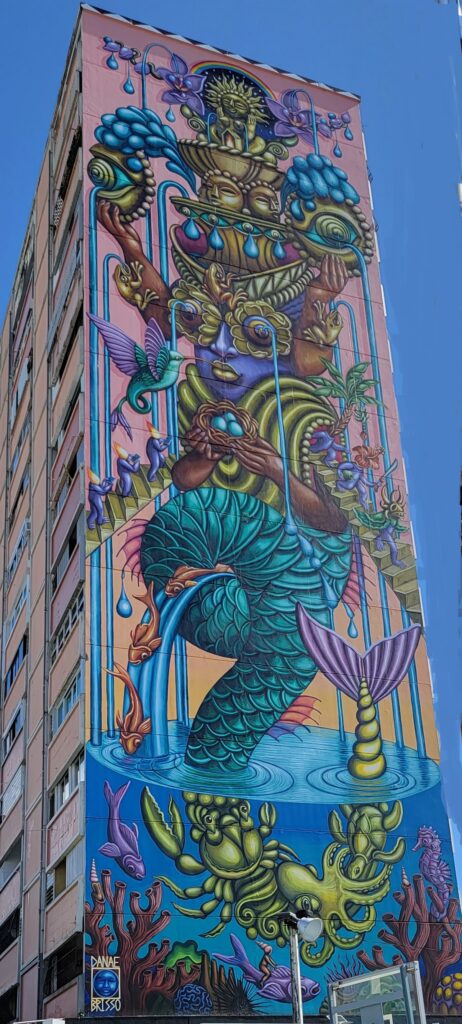
Art in San Juan: Our first exposure to art on the island literally had us looking upwards. The Santurce neighborhood of San Juan is known for its colorful murals painted on buildings. Santurce es Ley (Santurce is Law) Urban Art Festival, an annual celebration, takes place in the adjacent Miramar district on Hoare and Cerra streets (La Calle Cerra). As a result of this fair and artists working at other times, we saw the work of some of the most significant mural and large-scale artists from Puerto Rico and internationally.
Torres described the illustrations and symbols on a 150-foot-tall mural titled Like Water (shown above), created by international artist and Canadian Danae Brissonnet, as quintessentially Puerto Rican. Other murals she pointed out depicted aspects of Puerto Rican history, music, or culture. La Calle Cerra also houses famous record studios, including Fania Records, and some murals pay tribute to great musicians from Puerto Rico. Members of our group took many photos, enjoying colorful art and sculptures on our walk.
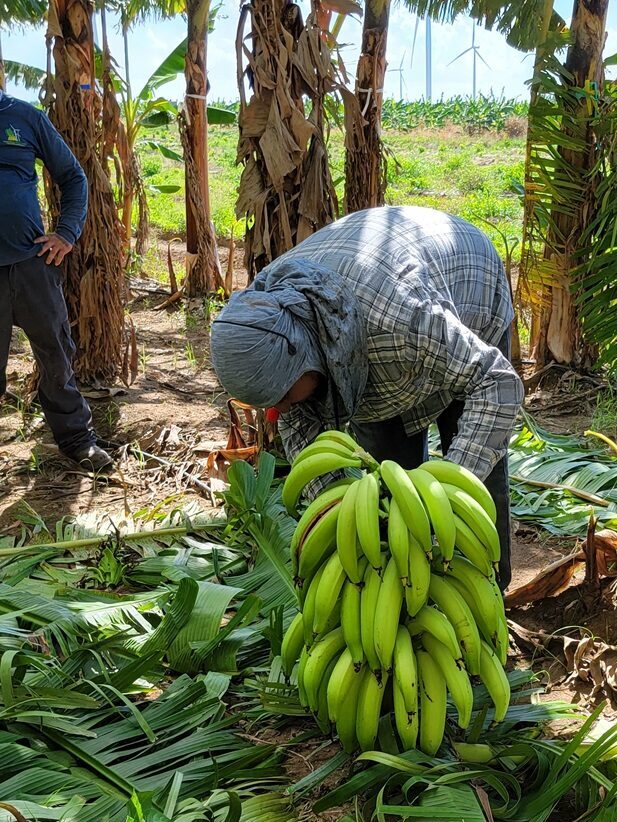
Tropical fruit farm: We soon set out for Ponce (named after Ponce de Leon, a governor of Puerto Rico when the Spanish colonized it in the 16th century). Along the way, we stopped at the Finca Don Manuel farm in Santa Isabel for a hayride that included a taste of pineapple and coconut water directly from the fruit – quite refreshing on a hot and humid day. Farm staff demonstrated, under plantain trees, how they harvest the plantains (shown above), popular in Puerto Rican cuisine. Interestingly, a feature here was the promotion of wind turbines on the farm (background of photo) as a government incentive.
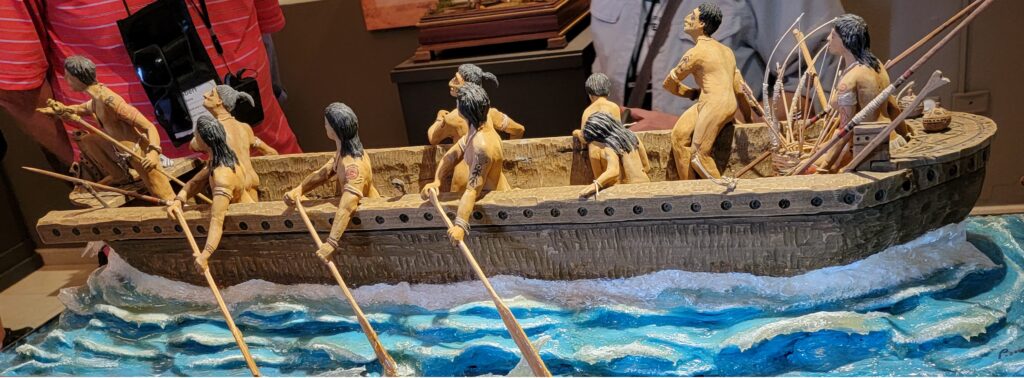
Earliest settlers: A field trip at the Museo de la Historia de Ponce — Museum of the History of Ponce, inaugurated in 1992, showed us one of the city’s most active cultural centers, preserving and presenting important aspects of Puerto Rican and Ponceño history and culture. We were exposed to island origins through exhibits that included dioramas of the indigenous Tainos (shown above) and how they hunted; ecology; and how Puerto Rico’s various cultures mixed or remained separate—among them Taino, West African, and Spanish.
Politics, economic activity, architecture, urban development, health and medicine were also part of the exhibit. A tour of artifacts at this archeological site revealed the pottery, tools, weapons and human remains of the original settlers of Puerto Rico, the Taino people. The museum is housed on a street that combines Moorish, neoclassical, and Ponceño architectural elements.
We walked through Delicias Square, a park in the Ponce city center. Several historical buildings surrounded the park, including the Ponce Firehouse, known for its signature black and red colors and an example of Spanish colonial architecture. Schoolchildren in red and black uniforms formed a long, half-block line across the street at the popular Kings Cream ice cream store.
Coffee and corn flour plantation in Ponce: We toured Hacienda Buena Vista, a historic coffee plantation, which included a lush rainforest, home to a variety of plants and animals. Its scenic waterfall was a treat for the eyes as were various plant species, including cacao trees, which today are farmed for produce.
We also learned about the plantation and slavery, which, unfortunately, were part of the island’s agricultural history. The tour guides discussed and demonstrated the restored 19th-century coffee and corn flour grinding mills, which staff turned on to show that they still work as they did in the 1800s. The coffee turbine won engineering awards at the time. The machine would strip coffee beans of their shells, then the unfinished product would be shipped to, and fully processed in Europe.
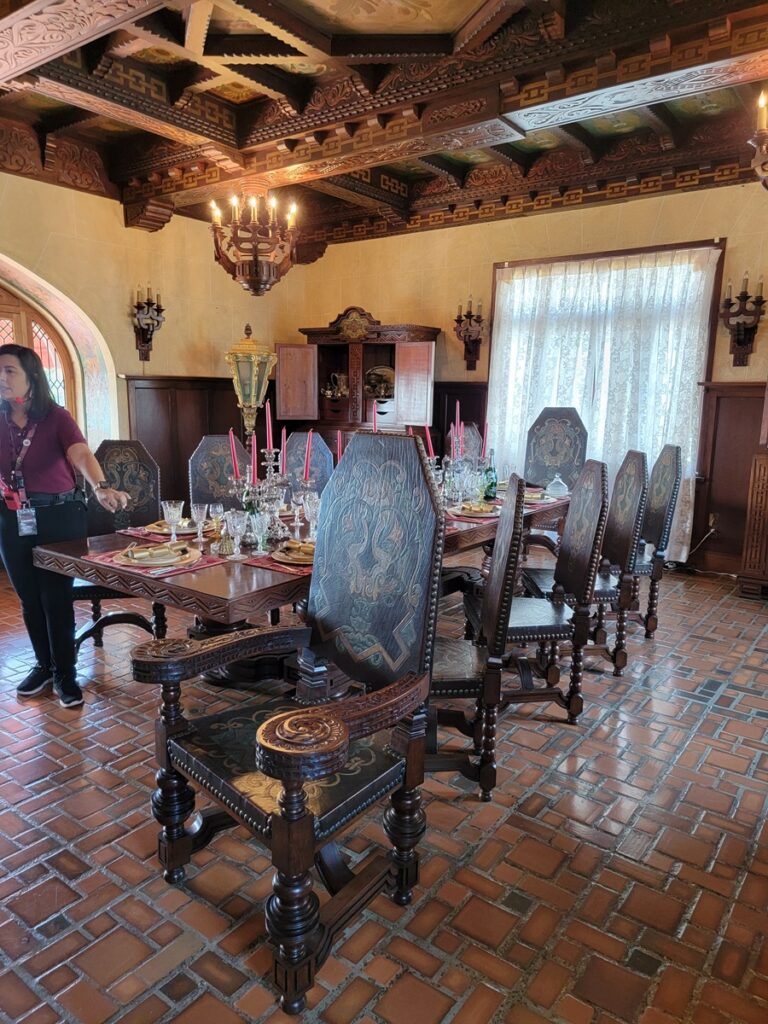
Don Q Rum Castle (El Castillo Serrallés): We learned that Puerto Rico is arguably the world leader in rum production and the leader in the Caribbean, accounting for 70% of the rum consumed in the U.S. We visited The Serrallés Castle Museum, former home to the founder of Don Q Rum, Don Juan Serrallés and his family, later passed on to their descendants. Due to the high maintenance costs of El Castillo, the Municipality of Ponce now owns the castle, and the nonprofit Patronato del Castillo Serrallés Inc. manages it as a museum. Today, the family lives elsewhere in Ponce.
We browsed the home’s opulent antiques, lavishly appointed rooms (shown above), some with imported, artisan-crafted wood paneling, parquet flooring imported from Brazil, and the antique furnishings of its rooms, office, and even art deco bathrooms. A majestic fountain, today enclosed with a high ceiling, but in the day, an open, cooling outdoor space with high-spraying waters (and no ceiling to block the water stream), was an engineering marvel of the mid-1800s. The mansion’s terrace still offers scenic vistas of Ponce.
Sugar farms that were 19th century plantations then, lie on the city’s outskirts, and molasses, from which the rum is processed, is brought in from there, Central America and elsewhere in the Caribbean.
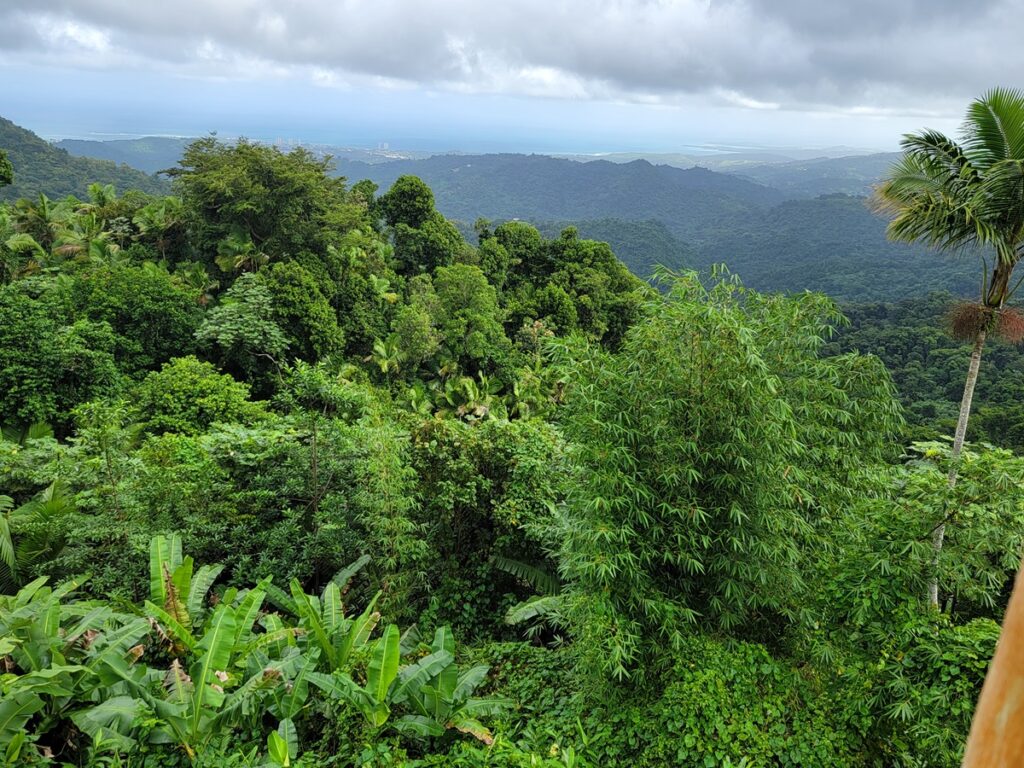
El Yunque rainforest: At another high point of the tour, Andrea Torres led a hike through the El Yunque National Forest (shown above), pointing out the flora, fauna and art installations. While El Yunque is one of the smallest U.S. national parks at 29,000 acres, its plant diversity is the largest, including both native and imported species. It is located in the high peaks of the northeast, offering temperatures as much as 20° cooler than the coastal regions. The Wata Jarobu members sported special T-shirts designed by Techi’s son for a group photo in front of the stunning El Yunque waterfall. The rest of us Road Scholars joined them for a second round of picture-taking.
Other remarkable sites we visited during this tour, rich in sight, sound, culture and information, included a memorable truck stop offering the native cuisine, including the well-known Lechón (roasted pig), pasteles, yuca, rice and beans, and plantains (green and ripe). San Juan’s Museo de Arte de Puerto Rico is an impressive and world-class art museum; Hacienda La Esperanza in Manati – is a historic sugar plantation now being restored by environmental nonprofit Para la Naturaleza. And a stop in Piñones on the island’s northeast coast, where we learned to dance to Plena and Bomba music beats (shown above) on a windy beach, honored the West African contribution to Puerto Rican culture.
Wata Jarobu members’ connections to the island: Techi, a Connecticut resident reconvening with the group in Puerto Rico, which she calls home, said she was only a “quasi-host” as Road Scholar took on the heavy lifting of tour activities. On the tour bus, she mentioned that her son has lived here for 25 years. After graduating from college, he “moved back home,” Techi said. During our excursions, she pointed out places of personal significance, including the Catholic school on our way to Manati that her late mother attended as a girl. Rocio’s personal history also traces back to her great-grandmother, born in Old San Juan.

On the last night of our journey, after a Spanish tapas dinner near the convention center in San Juan, Rivera gave a rousing speech (shown above), appreciating fellow tour group members, the Girl Scouts and Girl Guides, and both tour guide Andrea and bus driver Nelda. Performing a song in Spanish for us on the tour bus, she played a set of castanets that she had purchased that day on our last visit to Old San Juan to a rousing round of applause. (Along with local crafts and art, instruments are a recommended souvenir to bring home from Puerto Rico.) According to this writer, she has an excellent singing voice.
What became of these future leaders? “We were teenagers to start,” said Rivera, “but we were aspiring, at that feminist period of time, to become role models for other young women and girls to follow, a tradition of leadership that was initiated in the Girl Scouts.” One of the women from Australia recently retired from Parliament. Rocio Smith devoted her life to the service of others in social work. Others became educators. Another, Jeannie from Texas, was a missionary for 20 years in Honduras, where she owns a home. Rivera went into teaching, from there, into administration, and later, became a certified interpreter in the criminal courts of Massachusetts, Immigration and Social Security Appeals. She recently finished a seven-year term on the school board of education in Killingly, Conn.
“Whatever path we all took, it was a path of leadership no matter how small or large,” Rivera said. “The purpose was always to serve as role models, to show other girls growing up then and now, that it didn’t matter where you came from or what plans you had, you could always be a leader. You could always lead a troop of brownies if that’s what you wanted to do.”
“It’s never over. It’s never done,” Rivera said. “Culture and history do not have a beginning or an end. It’s life.”

